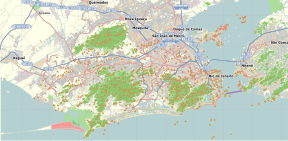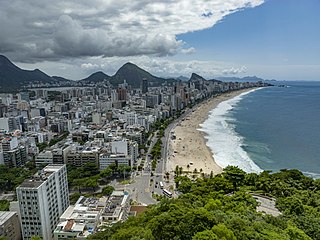
Leblon is a neighborhood of Rio de Janeiro, Brazil. It is also the name of the local beach. The neighborhood is located in the South Zone of the city, between Lagoa Rodrigo de Freitas, Morro Dois Irmãos and the Jardim de Alah channel, bordering the Gávea, Ipanema, Lagoa, and Vidigal neighborhoods. It is regarded as a very affluent area.

The Rio de Janeiro Metro, commonly referred to as just the Metrô is a rapid transit network that serves the city of Rio de Janeiro, Brazil. The Metrô was inaugurated on 5 March 1979, and consisted of five stations operating on a single line. The system currently covers a total of 58 kilometres (36 mi), serving 41 stations, divided into three lines: Line 1 ; Line 2, which together travel over a shared stretch of line that covers 10 stations of an approximate distance of 5 kilometres (3.1 mi); and Line 4. Metrô Rio has the second highest passenger volume of the metro systems in Brazil, after the São Paulo Metro.

Barra da Tijuca is an upper-middle class neighborhood or bairro in the West Zone of Rio de Janeiro, Brazil, located in the western portion of the city on the Atlantic Ocean. Barra is well known for its beaches, its many lakes and rivers, and its lifestyle. This neighbourhood represents 4.7% of the city population and 13% of the total area of Rio de Janeiro.

Rodrigo de Freitas Lagoon is a lagoon in the district of Lagoa in the Zona Sul area of Rio de Janeiro. The lagoon is connected to the Atlantic Ocean, allowing sea water to enter by a canal along the edge of a park locally known as Jardim de Alah.
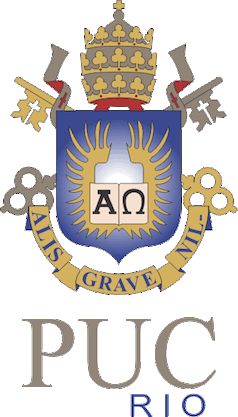
The Pontifical Catholic University of Rio de Janeiro is a Jesuit, Catholic, pontifical university in Rio de Janeiro, Brazil. It is the joint responsibility of the Catholic Archdiocese of São Sebastião do Rio de Janeiro and the Society of Jesus.

The Metropolitan of Fortaleza, also known popularly as Metro of Fortaleza or Metrofor, is a system of metropolitan transport that operates in the Brazilian city of Fortaleza, operated by Companhia Cearense de Transportes Metropolitanos, company of social capital, captained by the Government of the State of Ceará, in Brazil, and has as current president Eduardo Hotz. Founded on May 2, 1997, the company is responsible for administration, construction and metro planning in the state of Ceará, being present in the systems of Sobral and Cariri, having its main activity in Fortaleza and its metropolitan region.

The Porto Alegre Metro is a transit system operated jointly by the federal government, the state government of Rio Grande do Sul and the city of Porto Alegre through the company Trensurb in Brasil. It has 22 stations, totaling 43.8 kilometers (27.2 mi) of route, and carries about 175,000 users a day.

General Osório / Ipanema is a station on Line 1 of the Rio de Janeiro Metro located in the Ipanema borough of Rio de Janeiro, Brazil. It is the line's southern terminus. The station opened in December 2009.
Line 4 (Yellow) of the Rio de Janeiro Metro is the third metro line built in the city of Rio de Janeiro. It was completed on 30 July 2016, connecting the Barra da Tijuca neighbourhood in the West Zone, passing under São Conrado and Rocinha, to Ipanema in the South Zone. All stations are underground, but when arriving in Barra da Tijuca, trains exit a tunnel, pass briefly by an elevated bridge and go underground again.

Paulista-Pernambucanas is a metro station on Line 4-Yellow of the São Paulo Metro, operated by ViaQuatro, and it's located in the Consolação district. It has free connection with Consolação station of Line 2-Green, operated by São Paulo Metro. The station was renamed after a naming rights contract was signed between ViaQuatro and retail store company Pernambucanas in April 2023.
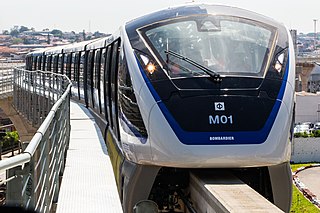
Line 15 (Silver) (Portuguese: Linha 15–Prata) is one of the six lines that make up the São Paulo Metro and one of the thirteen lines that make up the Metropolitan Rail Transportation Network. It is South America's first mass-transit monorail and is the first system in the world to use the Bombardier Innovia Monorail 300. When completed it will be the largest and highest capacity monorail system in the Americas and second worldwide only to the Chongqing Monorail. The first section, from Vila Prudente to Oratório, opened on 30 August 2014, initially running 10 AM–3 PM on weekends only. As of 26 October 2016, the line is operational from 4:40 AM–12 AM. The line has a free connection to Line 2-Green on Vila Prudente station and future connection to CPTM Line 10-Turquoise on Ipiranga station.

Botafogo Station is a subway station on the Rio de Janeiro Metro that serves the neighbourhood of Botafogo in the South Zone of Rio de Janeiro.

Uruguai / Tijuca is a station on the Rio de Janeiro Metro that services the neighborhood of Tijuca in the North Zone of Rio de Janeiro.

Saens Peña / Tijuca is a station on the Rio de Janeiro Metro that services the neighborhood of Tijuca in the North Zone of Rio de Janeiro.

São Cristóvão Station is a railway station in São Cristóvão, Rio de Janeiro which is serviced by the Rio de Janeiro Metro and SuperVia.

Jardim Oceânico / Barra da Tijuca is a station on the Rio de Janeiro Metro that services the neighborhood of Barra da Tijuca in the West Zone of Rio de Janeiro. It was previously simply named Jardim Oceânico, but was renamed alongside many others in August 2022 to include its neighborhood, Barra da Tijuca, in the name.

Varginha will be a train station on ViaMobilidade Line 9-Emerald, in the district of Grajaú in São Paulo. It is part of a plan of the State Government to extend the Line Emerald in 4.5 kilometres (2.8 mi) towards south of the city, from Grajaú station. It is being rebuilt in the place where was located the old Varginha station, which belonged to the Jurubatuba branch, of the extinct FEPASA.
Line 3 of the Rio de Janeiro Metro is a planned line which would connect Rio de Janeiro and Niterói. This is a challenge due to the fact that the line would need to cross the Guanabara Bay, presumably underwater. Niterói last had rail service of any kind in 2007 and its public transit is currently only served by buses and boats.
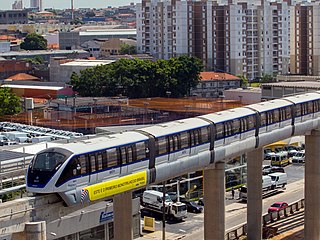
The São Paulo Metro M stock is a class of trains built by Bombardier between 2011 and 2014 to operate on Line 15-Silver, opened in 2014. This is the first monorail class of trains of the state of São Paulo.

